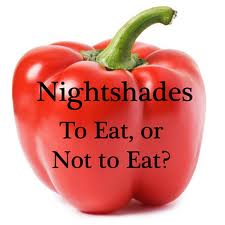
Nightshades Written by Garrett Smith, NMD Tuesday, 30 March 2010 00:25
Problems from these Popular Foods Exposed to the Light of Day The nightshades are members of an enormous family of plants called Solanaceae, represent a huge family of plants. The ones that concern us in the Western diet mainly include tomatoes, potatoes (not sweet potatoes or yams), eggplant and peppers—this means all peppers including chili peppers, habenero, cayenne pepper and paprika (not peppercorns, see sidebar). Paprika is a sneaky one, showing up in lots of flavoring mixes and often under “spices” on ingredient labels. Other nightshades include goji berries (the new darling of the antioxidant crowd), ashwagandha (an adaptogenic herb from Ayurvedic medicine), Cape gooseberries (not normal gooseberries), ground cherries and garden huckleberries (not blueberries).
I’m a licensed naturopathic physician in private practice, and I will admit right off the bat that I am biased against nightshades. I used to eat a ton of foods in the nightshade family, but now I avoid them as much as possible. I am one of those who is very sensitive to these foods. In my medical practice, I treat pain often. My goal in pain treatment is pain relief. In my opinion, pain management—that is, long-term painkillers, without a goal of true pain relief—is for suckers. For me and many of my patients, nightshade avoidance is the answer to long-term relief from pain.
Why should you care about this? It’s likely that you enjoy eating these foods and can’t imagine that they are bad for you in any way. Well, if you suffer from inflammation, joint pain and cracking, avoiding nightshades will lessen your pain, whether or not the nightshades are the true source of the pain. Are you sensitive to weather changes? This can be an indication of nightshade sensitivity. Muscle pain and tightness, morning stiffness, poor healing, arthritis, insomnia and gall bladder problems—these can all be caused by nightshades. Nightshades can also cause heart burn or GERD—a lot of people already know they react this way when they eat peppers or tomatoes.
Like soy, most nightshades are relative newcomers to European/Western diets. The tomato came to North America in the very early eighteenth century. It was termed the “love apple” and grown first as an ornamental. That means people grew it because it is pretty, yet they did not eat it. Why did they not eat it? They thought the tomato was poisonous. The leaves of the nightshade family are indeed overtly poisonous (livestock farmers know this well) and people avoided the fruit as well.
During a famine in 1782, Scottish highlanders complained of dropsy (an old term for edema or swelling, often associated with congestive heart failure) when they ate abundantly of potatoes.1 Russian prisoners of World War II returned with advanced cases of dropsy, which was blamed on heavy potato consumption.2 An old saying in New Hampshire in 1719 was that the white potato shortened men’s lives.
Eggplant was also first grown as an ornamental, a decorative plant. It was not eaten until relatively recent years in North America. According to Dr. Norman Childers, author of The Arthritis Diet, peoples of the Mediterranean area previously believed that the eggplant would cause insanity if it was eaten daily for a month, in fact, it had the nickname of “mad apple.”3 How many foods that you eat have a reputation like that?
It’s extremely easy to overdose on nightshades in Western culture, especially if you are a foodie. Let’s say you have salsa on your eggs at breakfast, potato salad at lunch, and eggplant with peppers along with other spicy dishes at dinner. This is a large amount of nightshades, eaten three times per day, in multiple combinations. It’s very hard to avoid the nightshades, believe me, it’s a lot of work! This can be easily demonstrated by reading the menu at any restaurant— nightshades have become ubiquitous. Nightshade sensitivity, in terms of the vigilance needed to keep them out of the diet, is almost as bad as gluten sensitivity!
For those of you who think you have tried “everything” for your arthritis pain, tried this and tried that but haven’t tried avoiding nightshades— in my opinion, it’s something you do need to try. I can tell you as a naturopathic doctor that I have tried many different remedies for my middle back pain. Nightshade avoidance got rid of 90 percent of it. If you’re one of those people whose pain treatments (be it chiropractic, acupuncture, laser, energy medicine, whatever!) provides only a day or two of relief, you’re quite possibly nightshade sensitive.
A physical therapist once told me that if a patient isn’t responding to treatment, one of the first things to consider is nightshade sensitivity— there is simply nothing else that anyone can do to help somebody in pain when nightshade sensitivity is the cause—because once they eat some nightshades again, their pain will return as it was before. Sad but true, as I have witnessed many times in my practice.